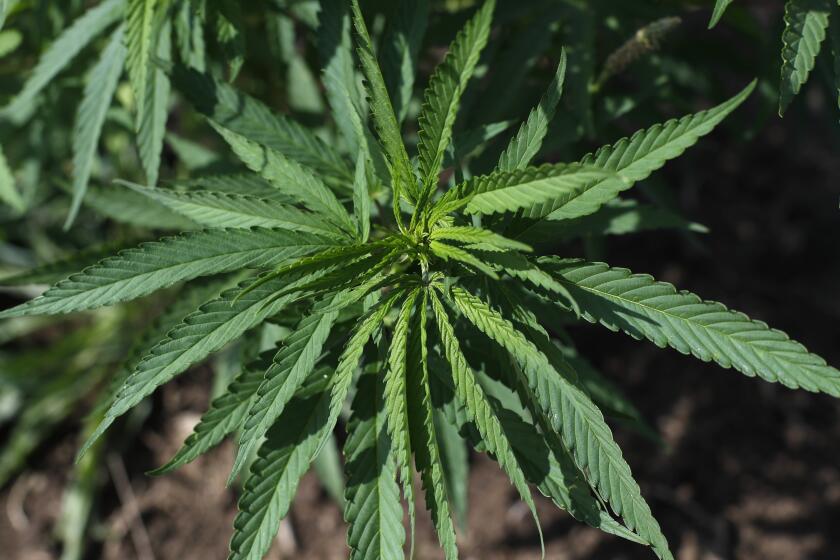Vast Canadian Border With U.S. Is an Easy Touch for Drug Smugglers
OTTAWA — They pose as a happy family on vacation but stuff their suitcases with marijuana. Others blithely sail into port with a hold full of liquid hashish, or dissolve their illicit cargo in windshield wiper fluid.
Whether the methods are obvious or ingenious, most drug smugglers in Canada are evading detection, say law enforcement agencies.
Only a fraction of the 90 million travelers who entered Canada last year were checked for narcotics and few drug shipments were intercepted, said Arthur Lewis, head of enforcement at Canada Customs.
“I’ve seen estimates as low as 5%,” he said. “We’re not naive enough to think we’re going to stop it.”
5,335-Mile Border
Vast empty spaces and a 5,335-mile border with the United States make Canada an easy touch for drug traffic in both directions.
“They’re trying to move farther and farther north because of (law enforcement) pressure in Florida and so little patrol capability here,” said Lewis.
Authorities rule out a U.S.-style “zero tolerance” blitz at the border because of concern for constitutional rights. “I don’t think our country would tolerate it,” said Detective Inspector Gerry Hawke of Ontario Provincial Police.
Canadian enforcers did seize 40 tons of illicit drugs last year and nab more than 10,000 people for drug offenses. Customs agents expect to confiscate drugs worth $330 million this year, a tenfold increase since 1982.
Large-volume traffickers use sealed ship containers and trailer trucks, knowing that police cannot possibly check them all.
“Trailers are lined up at all the bridges from the U.S., and we know a fair amount of drugs are coming in this way. But we can’t ask them all to unload,” said Hawke.
Many Ways to Smuggle
Drugs were also found in a baby’s diapers, jade figurines, a piano, the tubing of a luggage cart, scuba tanks, sacks of coffee, in the lining of running shoes, car windshield wiper fluid and a truck’s hydraulic system, officers said. One hardened cocaine solution was disguised as a shipment of ponchos.
A trawler was seized at Vancouver in British Columbia with eight tons of marijuana from Thailand, and a woman and her son were jailed for attempting to import $1.6-million worth of Colombian cocaine in 3.5-ounce packages sent registered mail.
“Swallowers and stuffers” concealing drugs on their person are the bane of airport security, said Inspector Neil Pouliot of the Royal Canadian Mounted Police. A chief method is to swallow condoms filled with cocaine.
‘Everything Is Fair Game’
Thorough body searches are increasing. “There is no moral code when you’re dealing with narcotics. Everything is fair game,” said Customs inspector Michael Crichton.
U.S. customs officers at Niagara Falls found $75-million worth of heroin in the false bottom of a suitcase two Vietnamese-born couriers were taking to New York. Police in Regina in Saskatchewan discovered a basement lined with aluminum foil where a forest of marijuana was growing hydroponically under 5,000-watt bulbs and an automatic watering system.
Neither Canada Customs nor the Royal Canadian Mounted Police even attempt to patrol the Great Lakes, an open invitation to drug merchants. “We rely on inside information so we can be there to meet them,” said Lewis.
His problem is that Customs has just 197 drug officers nationwide, aided by 32 dog teams sniffing baggage and cargo at ports of entry. The Mounties deploy 1,100 drug enforcers, including 27 liaison officers at Canadian embassies from Thailand to Jamaica and one each in Miami, New York and Los Angeles.
Concentrating on Suppliers
The country’s combined anti-narcotics force of 1,500 concentrates on suppliers, not users. Even with major busts, street prices declined last year as the flow continued.
The Mounties estimate the drug trade in Canada at $8.3 billion a year, while their budget to combat the scourge is less than $83 million.
“The market is expanding, there’s no doubt about that,” said the Mounties’ assistant commissioner, Marcel Coutu. “We could do a better job if we had more money and more people.”
Drug offenses also rose 9% last year; Montreal police say half the crime in the city is now drug-related. Marijuana remains the most popular drug, while Canada has about 500,000 cocaine users--compared to an estimated 12 million in the United States. Crack use is not widespread.
Soviet customs agents helped with the best tip of the year. They told the Mounties that a drug ring planned to ship 11,277 pounds of hashish from Kabul, Afghanistan, through Leningrad to Montreal. The hash was seized on arrival and three Canadians are now behind bars.
Counting on New Law
Ontario police hope a proposed new law will enable them to freeze the proceeds of drug trafficking when an arrest is made. Unlike U.S. legislation, however, the seized assets would not be earmarked to fight drugs.
The Italian Mafia, Chinese triads, Iranian, Pakistani and other criminal organizations control the heroin market, while Colombian crime families are flooding Canada with cocaine, according to the Mounted Police. Other drugs are imported by Vietnamese gangs in Vancouver, motorcycle gangs such as the Hell’s Angels and Satan’s Choice, and traffickers from Jamaica and Lebanon.
The foot soldiers in trafficking, or “mules,” are ordinary people recruited for cash, as a Jamaican immigrant in Toronto recently disclosed.
She told The Toronto Star she earned $16,600 bringing three suitcases stuffed with 150 pounds of marijuana back from Kingston. She sailed through customs by traveling with her husband and three young sons and pretending to be vacationers.
“The whole scam is so easy it’s ridiculous,” the 35-year-old woman said.
More to Read
Sign up for Essential California
The most important California stories and recommendations in your inbox every morning.
You may occasionally receive promotional content from the Los Angeles Times.










